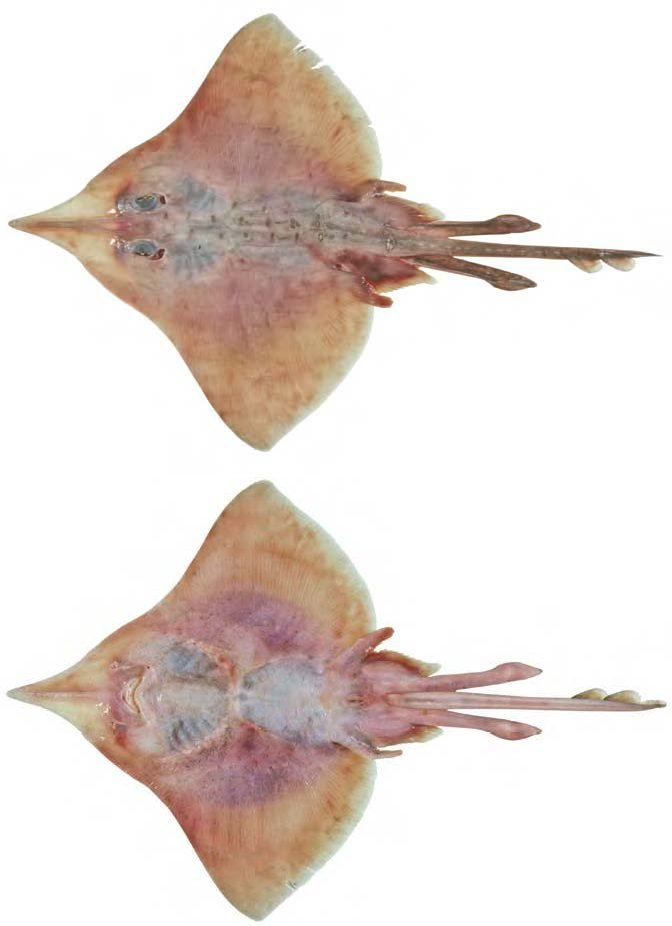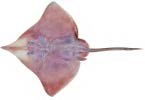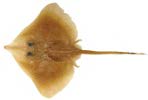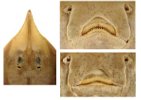Dentiraja healdi
(Last, White & Pogonoski, 2008)
Heald’s skate
Classification: Elasmobranchii Rajiformes Rajidae
Reference of the original description
New skates of the genus Dipturus (Rajoidei: Rajidae) from Australian Seas. CSIRO Marine and Atmospheric Research Paper, 21, 9–52
New skates of the genus Dipturus (Rajoidei: Rajidae) from Australian Seas. CSIRO Marine and Atmospheric Research Paper, 21, 9–52
Image of the original description

Dentiraja healdi sp. nov, adult male holotype (CSIRO H 4071–15, 579 mm TL, fresh): A, dorsal surface; B, ventral surface; In: Last, P.R. & White, W.T. & Pogonoski, J.J. 2008 New skates of the genus Dipturus (Rajoidei: Rajidae) from Australian Seas. CSIRO Marine and Atmospheric Research Paper, 21: 9-52

Dentiraja healdi sp. nov, adult male holotype (CSIRO H 4071–15, 579 mm TL, fresh): A, dorsal surface; B, ventral surface; In: Last, P.R. & White, W.T. & Pogonoski, J.J. 2008 New skates of the genus Dipturus (Rajoidei: Rajidae) from Australian Seas. CSIRO Marine and Atmospheric Research Paper, 21: 9-52
Synonyms / new combinations and misspellings
Dipturus cf. healdi, Dipturus healdi
Dipturus cf. healdi, Dipturus healdi
Types
Dentiraja healdi
Dipturus healdi
Holotype: CSIRO: H 4071-15; Paratype: CSIRO: H 4071-14; CSIRO: H 4071-16; CSIRO: H 2897-05; CSIRO: H 2897-06; CSIRO: H 2273-03; CSIRO: H 1652-04; CSIRO: H 1650-01; CSIRO: H 1636-03; CSIRO: H 1207-03; CSIRO: CA 4406; CSIRO: CA 4368; CSIRO: CA 4381; CSIRO: CA 4364; CSIRO: CA 3911; CSIRO: CA 4394; CSIRO: CA 4383; CSIRO: CA 2828; CSIRO: CA 2827; WAM: P 28081-003; WAM: P 28127-002; WAM: P 28074-005;
Dentiraja healdi
Dipturus healdi
Holotype: CSIRO: H 4071-15; Paratype: CSIRO: H 4071-14; CSIRO: H 4071-16; CSIRO: H 2897-05; CSIRO: H 2897-06; CSIRO: H 2273-03; CSIRO: H 1652-04; CSIRO: H 1650-01; CSIRO: H 1636-03; CSIRO: H 1207-03; CSIRO: CA 4406; CSIRO: CA 4368; CSIRO: CA 4381; CSIRO: CA 4364; CSIRO: CA 3911; CSIRO: CA 4394; CSIRO: CA 4383; CSIRO: CA 2828; CSIRO: CA 2827; WAM: P 28081-003; WAM: P 28127-002; WAM: P 28074-005;
Description :
Citation: Dentiraja healdi (Last, White & Pogonoski, 2008): In: Database of modern sharks, rays and chimaeras, www.shark-references.com, World Wide Web electronic publication, Version 12/2025
Please send your images of "Dentiraja healdi" to info@shark-references.com

Dorsal surface of Dentiraja healdi sp. nov. female paratype (CSIRO H 1650–01, 567 mm TL, fresh); In: Last, P.R. & White, W.T. & Pogonoski, J.J. 2008 New skates of the genus Dipturus (Rajoidei: Rajidae) from Australian Seas. CSIRO Marine and Atmospheric Research Paper, 21: 9-52

Dorsal surface of Dentiraja healdi sp. nov. female paratype (CSIRO H 1650–01, 567 mm TL, fresh); In: Last, P.R. & White, W.T. & Pogonoski, J.J. 2008 New skates of the genus Dipturus (Rajoidei: Rajidae) from Australian Seas. CSIRO Marine and Atmospheric Research Paper, 21: 9-52
Common names
 Heald's skate,
Heald's skate,  Leyland's skate
Leyland's skate
 Heald's skate,
Heald's skate,  Leyland's skate
Leyland's skate
Short Description
Original Diagnosis of LAST, WHITE & POGONOSKI, 2008 [3309]: A medium-sized species of Dipturus (to 72 cm TL) with the following combination of characters: disc relatively broad with narrowly rounded to angular apices, width 64–68% TL, 1.1–1.2 times its length; snout angle 64–74°; tail length 0.8 in distance from snout tip to rear of cloaca; tail slender, somewhat rounded in crosssection, width 1.5–1.8 times height at its midlength, 1.5– 1.8 times at first dorsal-fin origin; pre-upper jaw length 19–22% TL, 2.3–2.7 times internasal width; ventral head length 33–35% TL; snout length 3.9–4.6 times interorbital width; orbit diameter 53–85% interorbital width; first dorsal-fin height 1.6–2.4 in its base length; distance from first dorsal-fin origin to tail tip 2.8–3.2 times first dorsal-fin base length, 2.2–3.2 times caudalfin length; pelvic fins of medium size, length of posterior lobe of adult males 17–18% TL, length of anterior lobe 69–74% of posterior lobe; adult clasper elongate, 27– 28% TL, connected to pelvic-fin inner margin at about 32–33% of its length from cloaca; anterior margins of both surfaces of disc of adult males with bands of granular denticles, dorsal bands absent in juveniles and large females; nuchal thorns usually absent (single weak thorn occasionally present); malar thorn patch small; tail usually with a single thorn row in males, 1–2 additional pairs of variably developed lateral rows in females; total pectoral radials 74–79; trunk centra 26–30; predorsal centra 76–84; total centra about 121–128; tooth rows in upper jaw 34–40; uniformly pale yellowish brown dorsally; greyish centrally with a paler outer disc and tail ventrally; gill membranes whitish, strongly demarcated from adjacent ventral head; ventral sensory pores small, distinct, black-edged, sometimes surrounded by small dusky blotches.
Original Diagnosis of LAST, WHITE & POGONOSKI, 2008 [3309]: A medium-sized species of Dipturus (to 72 cm TL) with the following combination of characters: disc relatively broad with narrowly rounded to angular apices, width 64–68% TL, 1.1–1.2 times its length; snout angle 64–74°; tail length 0.8 in distance from snout tip to rear of cloaca; tail slender, somewhat rounded in crosssection, width 1.5–1.8 times height at its midlength, 1.5– 1.8 times at first dorsal-fin origin; pre-upper jaw length 19–22% TL, 2.3–2.7 times internasal width; ventral head length 33–35% TL; snout length 3.9–4.6 times interorbital width; orbit diameter 53–85% interorbital width; first dorsal-fin height 1.6–2.4 in its base length; distance from first dorsal-fin origin to tail tip 2.8–3.2 times first dorsal-fin base length, 2.2–3.2 times caudalfin length; pelvic fins of medium size, length of posterior lobe of adult males 17–18% TL, length of anterior lobe 69–74% of posterior lobe; adult clasper elongate, 27– 28% TL, connected to pelvic-fin inner margin at about 32–33% of its length from cloaca; anterior margins of both surfaces of disc of adult males with bands of granular denticles, dorsal bands absent in juveniles and large females; nuchal thorns usually absent (single weak thorn occasionally present); malar thorn patch small; tail usually with a single thorn row in males, 1–2 additional pairs of variably developed lateral rows in females; total pectoral radials 74–79; trunk centra 26–30; predorsal centra 76–84; total centra about 121–128; tooth rows in upper jaw 34–40; uniformly pale yellowish brown dorsally; greyish centrally with a paler outer disc and tail ventrally; gill membranes whitish, strongly demarcated from adjacent ventral head; ventral sensory pores small, distinct, black-edged, sometimes surrounded by small dusky blotches.
Remarks
shark-references Species-ID=14786;
shark-references Species-ID=14786;




















